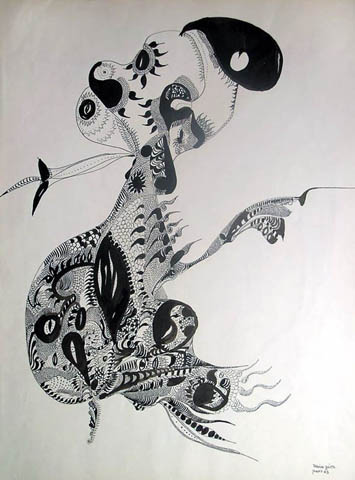
I have always been intrigued by the inherently raw nature and emotional purity of illustration, so I was thoroughly excited to visit the Drawing Center's Unica Zürn: Dark Spring exhibition. A German artist and writer, Unica Zürn (1916-1970) was raised in Weimar Berlin to a privileged family. Earning a living as first an editor and journalist, she married and bore two children, but lost her family when her husband was eventually granted custody after they divorced. In 1953, she began a tumultuous relationship with German Surrealist artist Hans Bellmer and joined him in Paris. There, she quickly became immersed within the Surrealist circle, which included Henri Michauxm who introduced Zürn to dangerous dabbling with mescaline and would ultimately lead to a series of mental breakdowns and struggles with schizophrenia until her suicide in 1970.


Grossly under-recognized within and beyond her lifetime, Zürn's beautifully intricate illustrations are a Surrealist's dream - a lyrical amalgamation of mythical creatures, disembodied faces, curiously inquisitive floating eyes, peculiar amoeba-like organisms and bizarre plant life. These fantastical ecosystems are a product of automatism and pure intuition; a manifestation of her troubled psyche, her drawings are a play between a lulling, haunting dream and a reckless imagination on the cusp on madness. One can imagine a direct link between mind and medium, where these cluttered images spilled onto the paper without hesitation, apology and rationale.
At once soothing and disturbing, her seemingly chaotic works evoke not horror but a churning, shifting state of emotional, physical and mental anguish. Here, all is possible as birds merge into fish, fossil-like imprints fan out over disfigured faces, scaly swirls enclose curious creatures that, instead of struggling their way out, seem to meld and conform to their capture. In fact, upon closer viewing, these incongruous figures and creatures are not a random hodgepodge of images, but seem content to float about together in a cohesive mass to melancholic effect. However, the disparate elements do not seem to interact with another, but merely peacefully co-exist. This contrasting tension is further demonstrated by the strong, smooth, organic lines of her work, which are neither jagged or rough to suggest her fragile, agitated state. Instead, the harmonious lines curve, circle and converge on the surface. Despite the apparent chaos of her work, perhaps Zürn's works are not a literal reflection of her deteriorating mental state but an invitation to an imagined, whimsical reality to escape her inevitable decline.

Zürn was also known for her writings, including Hexentexte (1954), a book of anagrams, Sombre Spring (1969) and Jasmine Man (1971). The show also included writings, including letters she had written to Bellmer and Man Ray. Her scrawled notes offered further insight into her disturbed psyche and acted as a narrative for her work. It seems impossible to fully grasp the tortured thoughts that used such illogical images as vehicles of expression. But through our own frailties, we can certainly appreciate them. Indeed, instead of excluding us from the reality that existed within herself, her works invite us - at least for a little while - into her beautifully broken world.
